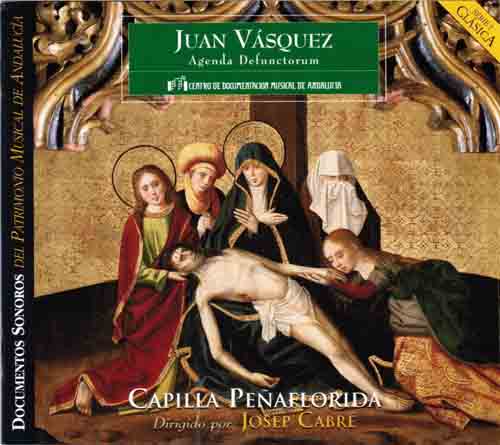Agenda Defunctorum
Detail DS - 0122 You can buy this record here 11 € Agenda Defunctorum Juan Vásquez
|
About THE COMPOSER Juan Vásquez was born in Badajoz around 1510. His first association with music was recorded in 1530 when he gained admission as a chorister at Badajoz Cathedral, where five years later he served as the succentor. Evidence of his musical prowess is that he was engaged as the music master to teach the choirboys in the same year that he was admitted as a chorister. In 1533 he was taken on as the singing instructor to teach not only the choirboys but also the prebendaries. In keeping with the mobility that characterised professional Spanish musicians throughout the Old Regime, in 1539 Vásquez was to be found at Palencia Cathedral engaged as a chorister. In 1541 he moved to Madrid at the request of García Basurto, the musical director serving Juan Tavera, the Archbishop of Toledo. Little is known of Vásquez's activity at this time and there is no record of him in Toledo or Arévelo, the latter being the Iocality to which the choristers forming part of this chapel moved. At any event, as Carmelo Solís remarks, it was in the decade of 1535-45 that Vásquez carne into contact with the circle of musicians in the service of the courts of the nobility. In 1545 he returned to Badajoz, this time as Musical Director, remaining in this position until 1550. Very little is recorded about him during this time, his trip to Villaviciosa in 1548 for health reasons being an exception. It was in this Portuguese locality that the Braganza ducal court resided, a veritable musical bridge between the neighbouring Iberian cultures. It was in 1551 that his relationship with Andalusia began, when he was engaged as a musician by the Sevillian noble Antonio de Zúñiga, to whom he dedicated the hymns and songs published in Osuna in 1551. However, what is most significant is that Vásquez's relationship with Andalusia meant that he carne into contact with Friar Juan Bermudo, Cristóbal de Morales, and Francisco Guerrero. 1560 saw the appearance of Vásquez's last work, a Compilation of Sonnets and Hymns which contained a collection of his secular compositions. The dedication is proof that Juan Vásquez was then still in Seville, where he was thought to have died sometime around 1560. However, according to recent research, he seems to be identified as a Musical Director in the service of the Duke of Medina Sidonia in around 1571-72, which adds to the uncertainty surrounding the date of his death.
OFFICE FOR THE DEAD Polyphonic settings composed as official prayers for deceased members of the congregation are without doubt one of the richest chapters in Renaissance polyphony. In the late 15th century requiem masses, following the pattern set by Ockeghem, started to become popular. It was, in the opinion of J. López-Calo, Cristóbal de Morales who established the requiem mass model in Spain. Two of his masses have been preserved, one in four voices and the other in five. The latter was edited in 1544 and there is a record of the existence of various copies of the other attesting to its dissemination. In addition to the masses, he composed settings for several portions of the office for the dead. The fact that Cristóbal de Morales and Juan Vásquez knew each other (the latter arrived in Seville in 1551 and Morales died there two years later in 1553) is, we believe, important to the theme of the office for the dead. Seville provided the meeting point for two composers whose compositions in this domain represented the loftiest peak of the Spanish Renaissance Missa pro Defunctis. Juan Vásquez's Agenda Defunctorum was edited in the city of Seville in 1556. The volume is dedicated to "Joanni Bravo, viro nobilissimo ac domino suo". This office for the dead can be considered a milestone in the development of the genre at this time, since it was rare for settings to be developed for the entire office, in addition to the Requiem Mass. Many composers composed masses for the dead, and the development of individual motets, responsorials, and psalms allusive to the office for the dead was usual, but it is rare to find a coherent, unitary idea which musically encompasses the entire office for the dead. In this sense, in the words of Samuel Rubio, of the works composed by the Renaissance polyphonists, the Agenda Defunctorum is the most complete in this genre. If the use of the Gregorian chant in polyphonic settings is a common feature in Renaissance compositions, in this Agenda plainchant occupies a prominent position. Of the twenty-seven numbers making up the Agenda, there are no more than half a dozen which are not based on some plainchant theme. Juan Vásquez's Agenda therefore constitutes a veritable catalogue of the Renaissance practice of using plainchant as cantus firmus. Several authors remark on the diversification of Vásquez's style with respect to the polyphonic style which was prevalent at that time —we are reluctant to use the term international, because it would seem to signal opposition to national style— a style that would later be known as Palestrinian. However, as H. Mayer Brown points out with reference to the composer Juan de Anchieta, a question pending further study is whether Spanish composers living around 1500 thought in tercos of simultaneous sonorities and sequences of sonorities. This practice, fused with the contrapuntal technique then in vogue, broadens the expressive potential of the music, emphasising the meaning of the text. All this applied to the office for the dead results in the production, in the fitting words of Samuel Rubio, of veritable musical mourning, the Agenda Defunctorum by Juan Vásquez. JON BAGÜÉS |

